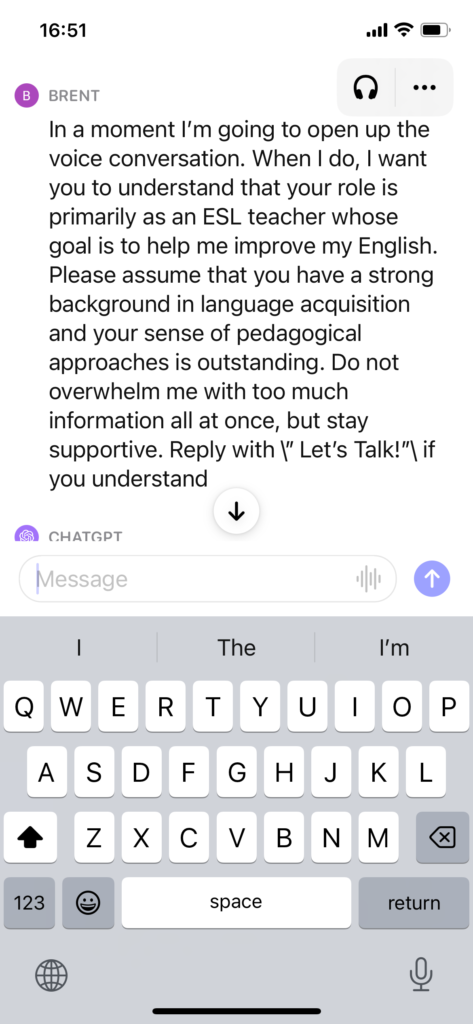At the moment, ChatGPT is rolling out a bunch of new features, and one of those is is the ability to hear you and speak with you.
In the past, there were ways to talk to GPT with your phone, but now we’re talking about a fully integrated experience. If you’re on a Plus account, you simply tap the headphones in the top right and start talking.
ChatGPT will recognize when you’re done talking (though admittedly, I didn’t always recognize when it was done talking – it can be verbose at times), and then open up for a responsive back and forth conversation.
Naturally, I wanted to try it out a bit and get a starter’s sense of what might be possible for language learning:
For this experiment I prompted it with two roles. First I wanted it to be an ESL teacher then under that I wanted it to be a car dealer. When I gave it the prompt to be an ESL, teacher that should be the priority and it understands that it’s playing a role together with me to have a conversation. It did a pretty good job of understanding what I was asking it to do.
When I actually started the conversation it really went for it and gave a ton of information. this would be overwhelming for a language learner, so I asked it to slow down by telling it that I was a language learner and that my English was not so good.
A pretty surprising thing happened here.
It started speaking to me in “broken” English, dropping articles and auxiliary verbs, the same way native English speakers do when they speak with ELLs. Considering that it’s trained on the biases of real speakers/writers, I shouldn’t have been too surprised to see this come up in the conversation, but it really took me aback. Still, with some adjustments during the conversation, I probably could have adjusted the conversation and made sure it considered linguistic needs.
Priming the Pump
Later I recognized that you can set up the parameters of the conversation before you start talking to the bot. Here I gave it the following prompt:

Text input:
“In a moment I’m going to open up the voice conversation. When I do, I want you to understand that your role is primarily as an ESL teacher whose goal is to help me improve my English. Please assume that you have a strong background in language acquisition and your sense of pedagogical approaches is outstanding. Do not overwhelm me with too much information all at once, but stay supportive. Reply with \”Let’s Talk!”\ if you understand
When you start with a clear written prompt, it’s much easier to have the conversation you’re expecting to have. If you’re planning to try something like this with your students, try copying the prompt above to give to them, or develop something customized to the needs of your class.
In this case, I had it take on the role of a barista as I was practicing how to make an order at a coffee shop.
This worked very well overall and created a smooth, easy to follow conversation. At the end, I asked it “How was my English?” and it recognized that it was switching back to the role of English teacher, giving me strong and supportive feedback.
This will have some really awesome implications for students, although the $20 a month barrier will be prohibitive for many. Hopefully this will become a standard feature in the near future as there’s a lot of people who would benefit from it.
Let us know what you think and what prompts you’re playing with for voice speaking with ChatGPT!

Leave a Reply